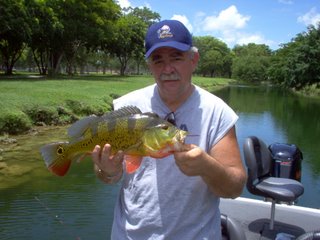 fact that you reading this blog demonstrates you share our excitement. We have had thousands of clients in search of the mighty Peacock and would be delighted if you would allow us to make your next trip a dream come true with one of our professional Florida bass fishing guides. Weather you fish conventional style or like fly fishing our guides are equipped for any angler, novice or the enthusiasts.
fact that you reading this blog demonstrates you share our excitement. We have had thousands of clients in search of the mighty Peacock and would be delighted if you would allow us to make your next trip a dream come true with one of our professional Florida bass fishing guides. Weather you fish conventional style or like fly fishing our guides are equipped for any angler, novice or the enthusiasts.We fish for the mighty Peacock bass from several different urban locations, to get directions to the most common location click here. The fishing will consist of small lakes, canal systems and deep water structure. The Peacocks can be caught several different ways, the most conventional is topwater, although rattle traps, hard stickbaits and some plastics work exceptionally well. Live bait is always an option and especially good for running up the numbers. The fly fishing enthusiasts will get a thrill for sure, as the Peacock will test your skill and equipment.
Although its basic shape very closely resembles that of the largemouth, it is not actually a member of the largemouth family. It belongs to a family of fish known as "cichlids", one of that boasts more than 1,000 species worldwide and is well known to tropical fish enthusiasts. Like the largemouth, the cichlid prefers to ambush unsuspecting pray from a stealthy vantage point and demonstrates a gluttonous appetite. The similarity ends there, however the Florida Peacock bass is much more eye appealing than its North American counterpart, colorfully adorned in varying shades of green, blue, orange and gold. Don't let this appearance fool you however. It's one of the toughest freshwater species in the world, the bone-jarring strikes, aerial acrobatics and line-stripping runs make it the ultimate quarry for both the fly and plug angler. It routinely breaks line and destroys tackle.
Although four distinct species of peacock bass, known as pavon in Venezuela, Colombia, Peru and Brazil, are from South America, at lease two or more of the species have made its way to North America (South Florida).
A common characteristic shared by all the species is the black circular "eye spot" dramatically rimmed in gold on the base of the caudal fin. Since this spot closely resembles the one found on the tail plume of the land dwelling fowl, and the profile of the species resembles the North American largemouth, the name Peacock bass became the perfect moniker. The butterfly pavon is one of the most colorful and more plentiful. Typically average two to four pounds, but as seen in the picture above they are getting much larger. (7.6 lbs)
Hope you decide to join us on your next fishing adventure!
Tight lines,
Capt Todd Kersey
todd@bassonline.com
www.bassonline.com
888 629-BASS